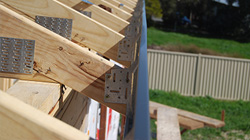Interline Roofing Ballarat – Flashing
Waterproofing the roof is vital for the integrity of the building, and one of the most important steps for doing so is the installation of the roof flashing. Read on to learn more.
What is Roof Flashing and why is it Necessary?
A complete flashing system needs to be installed during construction. This system intercepts, collects, and discharges moisture or water back onto the roof stormwater drainage system. Apart from malleable flashing which is fitted on site, roof flashing should be purpose made and machine folded, of material that is compatible with all of the materials used in the stormwater drainage system.
The waterproofing of roofs is vital to maintain the structural integrity of the building. A defective roof flashing system is a common cause of water penetration into a roof. Also, masonry walls can be porous, absorbing moisture, coupled with capillary action, can allow moisture to penetrate into internal surfaces. In these cases, flashing is needed in order to redirect the moisture back out to external surfaces.
Common spots for water penetration on roofs for exterior walls are where surfaces intersect. These include where dormer walls and the roof join, around skylights and chimneys, and in roof valleys. Other vulnerable areas include areas where the water runoff can be heavy, such as in valleys and eaves. Flashings provide the necessary extra protection.
Types of Roof Flashings
- stepped flashing
- flashing between existing roofs and patio additions
- flashing around curved surfaces
- hip and valley flashing
- apron
- counter (or over)
- hanging
- soaker flashing
Hang flashing protects the joints between the roof and dormer walls and chimneys. It fits to each course of bricks and looks as if it is stepping up a wall or other surface. Valley flashing protects the valleys where two roof planes meet. Hip and ridge flashing is installed to cover the end of all roof cladding. Vent pipe flashing fits over flues and pipes and is cone shaped with a flange at the base. Drip edges are strips that run along the roof’s eaves and rakes to stop water from seeping underneath the roofing.
Roof Flashing Materials
- Zincalume steel
- Colorbond steel
- Lead & Acrylead
- galvanised steel
- aluminium
- copper



